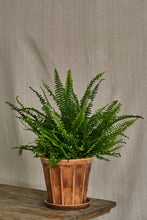More commonly known as Boston Ferns, Nephrolepis have been an indoor staple since the 70s. Their long and bushy fronds easily liven up a space, and their vibrant green shade helps them stand out when grouped alongside other tropical plants. As their fronds can grow to great lengths, they are often displayed in hanging pots or dangling from a high shelf, but look equally striking sitting low and bush-like.
Light: Bright but indirect
Nephrolepis do best in a brightly lit spot but won't withstand harsh rays of direct sunlight. Sitting on a north or east facing windowsill will provide plenty of light, or in a brighter room you can set them a metre or so back from a south or west facing window. We recommend turning the plant every now and then to encourage even growth.
Watering: Frequent
In spring and summer let the top inch of soil dry out before watering again. In the winter you can leave it a little while longer, but never let it fully dry out. The easiest way to check moisture levels is by sticking your finger into the soil to the required depth.
Humidity: High
Nephrolepis like a lot of moisture in the air. A warm bathroom or humid kitchen is ideal, but they can be placed elsewhere if you're doing something to increase humidity levels. Place a tray filled with stones and topped up with water beside the plant as this will slowly release moisture into the air throughout the day. High humidity must also be combined with warmth as Nephrolepis suffer quickly in the cold.
Note:
Browning on the tips of the leaves is usually an indication that there isn't enough moisture in the air. This can be combatted in many ways so fear not! The pebble tray mentioned above is highly effective, but you can also mist the leaves daily to be on the safe side. Grouping your plant with other tropical plants will help too as they will create a tropical microclimate.




